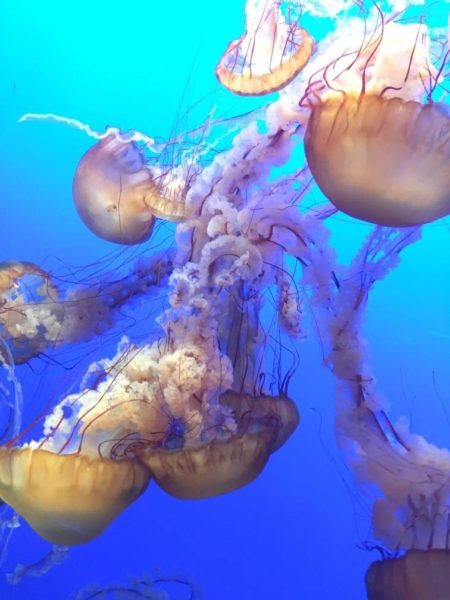
A New Book on Jellyfish is Filled with Wonder and Climate Change Woes
Berwald pops between scientific conferences and labs, fishes for giant jellyfish off the coast of Japan and dives with a swarm in Israel.

Jellyfish drift. It’s practically their defining feature. Many creatures have hard parts of one kind or another; jellies are 95 percent water, and look it. Their bodies pulse with motion, from the slow contractions of gelatinous bells to the drifting spray of their tentacles, but they don’t seem terribly motivated. They have none of the brute charisma of the shark, the majesty and color of tropical fish, or the worrying intelligence of the octopus. By our standards, they are brainless and ephemeral. Over the past century, their grasp on public attention has been consequently slippery. When they attract notice, it’s often as a kind of living art, or a nuisance at the beach.
But as the Austin science writer Juli Berwald argues in Spineless — a wandering, compelling mixture of memoir and nature writing — jellyfish are quite a bit more sophisticated than we give them credit for. They belong to the Cnidarians, a bustling and diverse group that includes corals, anemones, the freshwater hydra and the lovely, lethal Portuguese man o’ war. Jellies come in freshwater and marine varieties, inhabiting warm surface seas and deep abyssal plains with equal pleasure. Some are smaller than a human thumbnail. Others, like the behemoth lion’s mane, can grow more than 100 feet long. Box jellyfish have developed a perfect eye lens that they can’t quite see with and a venom that can kill a person in minutes. Crystal and comb jellies respond to harassment with a flickering light show. And some species, like the immortal jellyfish, age from polyp to medusa and back again, possibly forever.
All of this experimentation is rooted on a body plan that seems remarkably simple, Berwald writes, but is probably better described as distilled. Jellies are the most efficient swimmers in the ocean: The bell — their squishy center — acts like a water balloon, springing back into place with minute contractions and propelling them through the water. Jellyfish sensory systems are equally pared down. Where more familiar animals have a central nervous system that keeps track of everything, jellies have something more distributed — a crowd-sourced network of motion triggers, any of which can override the others in a pinch. Most importantly, in favorable conditions jellies can reproduce like crazy.

by Juli Berwald
Riverhead Books
$17.70; 352 pages
Berwald covers all of this in clear, strong prose, a welcome help when dealing with the complex stew of biomechanics, chemistry and evolutionary theory that the subject entails. She threads in quite a bit of her own story, too: Berwald was a marine scientist in her 20s, before drifting away from it and ending up happily married — though landlocked — in Austin. While discussions of her insecurities and previous ill-fated relationships don’t always gel with the rest of the narrative, her adventures with fellow scientists find the book on much firmer footing. Berwald pops between scientific conferences and labs, fishes for giant jellyfish off the coast of Japan and dives with a swarm in Israel. One research team she interviews has built successive iterations of robots inspired by jellyfish motion; others have been exploring the nutritional benefits of jellyfish collagen. (It turns out that it’s likely exceptionally healthy, though after Berwald cooks some, she declares it fairly bland.)
For Berwald, though, jellies also represent the wider problem of the human-impacted ocean. Jellyfish populations expand and contract along natural cycles, though these aren’t well understood, and swarms are important to multiple species of marine animals. In the vast blue, sheets of jellyfish are the foundation for whole ecosystems of fish, large and small, which hide among the bells and wafting tentacles. Dead schools drift to the cold ocean floor, feeding abyssal crabs and hagfish; leviathans like leatherback turtles depend on them as well.
In the oxygen poor “dead-zones” off the Texas coast, jellies are some of the only creatures that can survive.
But jelly blooms have also grown increasingly common over the last few decades, while other populations have crashed. In 2013, a nuclear power plant in Sweden was forced to shut down after a wave of moon jellies clogged its seawater intake, threatening to overheat the reactor. Similar occurrences have happened in power and desalination plants in Japan, the United States, Australia and the Philippines. This year, Haaretz reported, the Israel Electric Corp. fished jellies by the ton out of a coal-fired power plant filter, resulting in piles that had to be moved by bulldozer. These explosions of jellyfish seem to be correlated to a growing amount of offshore construction, with everything from docks to wind farms providing a nice root for jellyfish polyps.
Blooms also have direct ecological impacts beyond their tendency to cause blackouts. Bacteria are attracted to jellyfish slime, and can gorge on it to the point where they crowd out phytoplankton, which many fish depend on. Left unchecked, the food web collapses. Polluted and overfished waters such as the Bohai Sea in China are now overwhelmingly dominated by jellyfish; international shipping and warming seawater have likewise conspired to spread some species far beyond their previous ranges, where they often reproduce in swarms. In the oxygen poor “dead-zones” off the Texas coast, jellies are some of the only creatures that can survive; in bays, inland oceans and other partially sheltered bodies of water, it’s possible that jellies could take over entirely. Or they might not. The ocean is not a uniform ecosystem, and jellies are as vulnerable to acidifying water as anything else. Nobody knows for sure.
Humanity is in the middle of its own bloom these days, the consequences of which are proving dire. Our relationship to the sea has gotten increasingly abusive over the last century, Berwald writes, leaving one of the last truly wild spaces in the grip of a truly stunning level of commercial extraction. A globalized ocean is a tamed ocean. But a globalized ocean is also, at least for now, a jellyfish ocean, prone to its own elegant expansions and contractions, constantly throwing up surprises and eventually causing all kinds of trouble. The worst effects of that world can still be avoided, but not if humanity continues to drift along its current path. As Berwald archly notes, at some point we’ll have to grow a spine.


